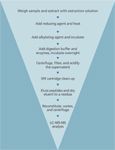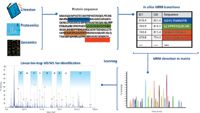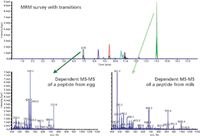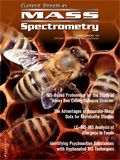Advanced Analysis of Allergens in Foods: LC–MS-MS Methodologies and Future Insights
Special Issues
An update on the sample preparation and LC–MS-MS tools available for allergen detection, as well advantages of those techniques.
Food allergies are becoming a global epidemic, and to the allergen sufferer, the need to accurately identify an allergen in a food product is a necessity. Bioanalytical methods to detect for allergens in foods can vary significantly, each offering its own advantages and disadvantages, and techniques are continuing to evolve and develop. LC–MS-MS has recently emerged as a new tool for allergen analysis, becoming the first technology that allows confirmatory analysis of multiple allergens in a single analysis. Here, we provide an update on the sample preparation and LC–MS-MS tools available for allergen detection in foods, as well as highlight some of the advantages that LC–MS-MS offers compared to other analytical techniques. We also discuss what the future holds for testing of allergens in foods — both for the scientist and for the allergen sufferer.
There is no doubt that food allergies are increasing among the global population. Whether this increase is because of the evolution of the food we eat, the introduction of different types or forms of food products into different world regions, genetics, or simply the increased use of sanitation products that weaken the immune system, the rise is definitely palpable (1). It is estimated that more than 150 million people worldwide have an allergy to one or more types of food (2). The most common allergies are related to egg, cow's milk, fish, peanuts, and rice. The only way to prevent an allergic reaction is to avoid the allergen given that there is no cure for food allergies. This means that accurate food labeling is an essential resource for concerned allergen sufferers.
Allergens almost exclusively consist of proteins, and an allergic reaction — ranging from mild rashes and hives to severe anaphylaxis or loss of consciousness — is the body's response to the presence of that protein. Scientific methods established to identify allergens in food are primarily bioanalytical methods, in which common approaches such as enzyme-linked immunosorbent assay (ELISA) and polymerase chain reaction (PCR) are set to target the intact allergen protein or the DNA that produced the allergenic protein, respectively. Newer methods also have recently emerged using mass spectrometry (MS), providing an alternative approach to allergen detection by analyzing fractions of the allergenic protein in the sample.
People with allergies rely heavily on food manufacturers and testing facilities to ensure that products are free of allergens and are labeled accordingly. These demands of the public are putting pressure on regulatory agencies that are governing food labeling laws as well as on food testing laboratories, which must strive to use the best technology to achieve accurate and reproducible results.
Traditional Methods for Detection of Allergens and Their Challenges
The PCR approach for allergen detection utilizes the remnant DNA in the sample from the allergen organism, amplifying its presence using a DNA polymerase enzymatic reaction. This approach, which incorporates unique DNA primers, is highly specific to the allergen of interest. As a result, PCR is less susceptible to cross-reactivity to different allergens. And, because PCR is an amplification reaction, typically only a small quantity of extracted DNA is needed, allowing low levels of allergens to be detected in the food. PCR also allows the detection of multiple allergens in a single sample preparation step through the use of assorted DNA primers that are specific to the series of allergens of interest.
Unfortunately, PCR has major drawbacks. First, because the method utilizes an indirect analysis of the allergen, quantification is often difficult. Additionally, false negatives can be observed, specifically in heavily processed foods, in which the DNA can be destroyed during processing. PCR also is more sensitive to the presence of food matrix components. Matrix components can often cause significant inhibition with the PCR, which also can produce false negative results.
Finally, and most importantly for foods such as baked goods, PCR is not suitable to detect egg and milk allergens. Although the approach works quite well for nut allergens, it cannot distinguish by-product proteins (egg and milk) from tissue proteins (chicken and bovine), which have identical DNA (3).
Although PCR is a good tool for some allergen detection in food, its drawbacks in the detection of egg and cow's milk allergens, two of the most common allergens, make it less suitable as a standard tool for multiple allergen analysis. This methodology also is not suitable for cooked or processed foods, because the processing could destroy the DNA and the matrix could produce high interference levels in the analysis.
The ELISA approach for allergen detection is based on the interaction of an allergenic protein with an antibody to that protein. In the presence of the allergen, the protein–antibody complex is reacted with an enzyme-labeled conjugate, a reaction causing a color change in the solution that may be detected using a spectrophotometer. ELISA provides a fast and easy-to-use methodology to detect for a single allergen in food, and it can be applied for the quick analysis of allergens in raw ingredients during the food production process.
However, ELISA methodology is not a catch-all approach. Every allergen of interest must be analyzed by a different ELISA kit specific to that allergen because antibodies are highly specific only to the allergenic protein of interest. This high degree of specificity of an antibody to an allergen protein also leads to the high possibility of false negative results. For example, many proteins are prone to modification during food processing or sample processing. Such modifications could inhibit the antibody–protein interaction, which might cause a negative ELISA result even if the allergenic protein is present.
ELISA methods also are susceptible to false positive results. For example, some egg proteins may cross react with the antibody for β-lactoglobulin, which is a major cow's milk allergen (4,5), making it difficult to determine if the food product contains egg, cow's milk, or both. Similar cross-reactivity has been noted for various tree nuts as well (5).
Given these drawbacks, challenges exist in the use of ELISA as a confirmatory analytical method for the determination of allergens in food products. With the expansion of food allergies among the global population, it is likely that regulatory agencies could initiate more stringent food labeling laws, requiring a methodology that would produce accurate, reliable, and confirmatory results. In addition to basic food labeling for the presence of allergens above specified target levels, ongoing studies to determine the correlation between clinical allergic reactions and the actual quantity of allergen present in a food product could encourage enforcement of thresholds or action levels (6).
Emerging Technologies for Allergen Detection
The newest analytical approach for allergen analysis that is gaining traction in global laboratories uses liquid chromatography–tandem mass spectrometry (LC–MS-MS) for the identification of allergenic peptides in food products. Rather than analyzing the full intact allergenic protein (as done with ELISA), LC–MS-MS allows for the direct analysis of digested peptide fragments of allergenic proteins, which are detected using their characteristic molecular masses.
There are two specific elements to the successful analysis of allergens by LC–MS-MS. First is the sample preparation, which is perhaps one of the most crucial steps in most analyses of complex matrices, such as food. Second is the proper identification and analysis of peptide markers that are specific to each allergen. Here, we discuss both of these elements.
Sample Preparation Developments for Allergen Analysis by LC–MS-MS
Food matrices are notoriously difficult to work with because of their many types (solids, liquids), and characteristics (polar, nonpolar). Whether it is a fatty matrix like milk, an oily matrix like peanuts, or a carbohydrate-rich matrix like bread, it is typically ideal to route these samples through a sample preparation process before analysis. Diligence upstream of the analysis with the proper sample preparation technique can lead to an improvement in the accuracy of results by lowering the level of detection (LOD), improving method sensitivity, and reducing the presence of interfering components.
The preparation of food samples for the analysis of allergens involves a lot of work, with most innovations coming forth in recent years. In 2008, Careri and colleagues published a sample preparation procedure for peanut allergen extraction from snack food products (7). Their innovative work paved the way for additional developments of modified, shorter sample preparation approaches for allergen analysis using LC–MS-MS detection. This new approach, pioneered by Heick and colleagues (8), (outlined in Figure 1) achieves lower limits of detection and tighter coefficients of variation between replicates through the incorporation of solid phase extraction (SPE).

Figure 1: Sample preparation approach for allergen analysis using SPE and LCâMS-MS.
Samples are homogenized using a food processor, then mixed with an extraction buffer containing ammonium bicarbonate, urea, and dithiothreitol — designed to extract the allergen proteins from the food in a reduced solvent environment. Samples are processed further using a roller mixer and then centrifuged. Iodoacetamide is added to the extract to serve as an alkylating agent to prevent reformation of disulfide bonds in the allergenic protein. Digestion buffer containing ammonium bicarbonate, acetonitrile, and trypsin is then added, and the proteins are digested into peptide fragments through an overnight incubation.
The digested sample presents a homogenate riddled with interfering enzymes, sugars, and matrix components, making SPE cleanup necessary at this juncture to remove these components. SPE also is important in this procedure because it concentrates the allergenic peptides, allowing for lower levels of detection. A sample SPE procedure for extraction of allergenic peptides from complex food matrices follows: A pretreated bread or pasta sample is loaded on an SPE cartridge (in this case, a 200-mg, 6-mL Phenomenex Strata-X cartridge) that has been conditioned with 6 mL of acetonitrile containing 0.1% formic acid and equilibrated with 6 mL of water containing 0.5% trifluoroacetic acid. The cartridge in this example is washed with 3 mL of 0.5% trifluoroacetic acid in water, and the analytes are eluted with 6 mL of acetonitrile. The analyte-containing solvent is then evaporated to dryness using nitrogen and reconstituted in 300 μL of 95:5:0.5 (v/v/v) water–acetonitrile–formic acid.
Innovations in research and development on sample preparation tools will play a fundamental role in the future of allergen analysis using LC–MS-MS.
Peptide Analysis and Identification by LC–MS-MS
LC–MS-MS is a powerful tool for the detection of allergenic peptides in food products. The primary benefit of using LC–MS-MS for allergen detection is the multiple levels of detection specificity, in which the presence of multiple target peptides as well as the unique masses and fragmentation patterns of those peptides allow a two-tiered allergen identification process, improving confidence and reliability in the detection of the allergen. Other benefits offered by LC–MS-MS are direct analysis of the allergenic proteins through their characteristic masses and fragmentation patterns; the ability to better quantify the allergen than with other methodologies; and the ability to detect multiple allergens in a single sample preparation procedure (9).
Allergenic peptides are first identified using databases and literature, primarily to ensure that the peptides are specific to the allergen and that they are not susceptible to modification during food processing. After peptides are identified and verified, a multiple-reaction monitoring (MRM)-initiated detection and sequencing (MIDAS, AB Sciex) workflow can be used for LC–MS-MS analysis of those peptide fragments. This workflow incorporates the power of MRM with full-scan linear ion trap MS-MS spectral data to allow the highest level of specificity for peptide identification and confirmation. An example of this workflow is shown in Figure 2.

Figure 2: Example of a multiple-reaction-monitoring initiated detection and sequencing workflow for allergenic peptide fragment analysis.
A sample MRM chromatogram of a bread sample fortified with egg and milk allergens using this LC–MS-MS workflow is shown in Figure 3. The workflow triggers the MS-MS spectrum of each peptide identified, offering richer mass spectral information and a higher level of confidence in the identification of that allergenic peptide.

Figure 3: Sample multiple-reaction-monitoring LCâMS-MS analysis of a bread sample fortified with egg and milk allergens.
There are several benefits with this MRM approach. First, this approach allows for the detection of peptides from multiple allergenic proteins if the peptides of those allergens are known. This overcomes the limitations of ELISA, in which only a single allergen can be detected at a time. Second, LC–MS-MS offers the ability for a reliable quantitative workflow, with lower limits of detection for milk peptides around 2 ppm and limits between 5 and 10 ppm for egg peptides. Reliable quantitation potential, in addition to the ability to achieve lower limits of detection at levels consistent with or below those identified with transitional methodologies, is another benefit of the LC–MS-MS workflow for allergen analysis.
The Future of Allergen Analysis
With food allergies becoming more and more common, especially among children, it can be speculated that authorities and regulatory agencies will begin to enforce more stringent food labeling laws in the coming years, perhaps also setting action levels (or minimum allergen levels that are acceptable for a product to be labeled "allergen-free") (6). Rigorous food labeling laws will lead to more rigorous testing protocols, and particularly the need for methodology that offers reliable, accurate, and confirmatory identification of food allergens in assorted consumer products. LC–MS-MS for allergen detection is the most ideal methodology to address these needs.
The LC–MS-MS methodology described here represents the beginning of innovations using this technique for allergen detection in food. As the information on allergenic peptide markers expands for a number of different allergens of interest (10) and innovations in sample preparation techniques evolve, allergen detection by LC–MS-MS will easily surpass traditional techniques for routine allergen detection in foods.
Conclusions
There are many different analytical methods to detect allergens in food products, and LC–MS-MS is emerging as a front-running methodology because of its robustness, specificity, and reliability relative to conventional methodologies. In this article, we presented recent studies showing the power of LC–MS-MS for allergen detection in food. This approach will continue to evolve to meet the demands of consumers.
As consumers and allergen sufferers wait to see how regulations will change, scientists and the technology industry will continue to push forward in researching and developing the most accurate and reliable quantitative methodologies for allergen detection. The evolution of advanced methodologies for allergen detection in food has only just begun.
Steven Lock is with AB Sciex UK Limited, in Warrington, Cheshire, United Kingdom.
Michael Rummel and Erica Pike are with Phenomenex Inc., in Torrance, California.
Lauryn Bailey is with AB Sciex in Framingham, Massachusetts. Please direct correspondence to: Lauryn.Bailey@absciex.com.
References
(1) M. Wills-Karp, J. Santeliz, and C.L. Kark, Nature Rev. Immunol. 1, 69–75 (2001).
(2) Elucidare, http://www.elucidare.co.uk/assignments/Project_Allergy/Global%20food%20allergies%20statistics.pdf.
(3) J. Lee and C. Kim, J. AOAC Int. 93(2), 462–477 (2010).
(4) Allergen Handbook, www.neogen.com.
(5) I. Selo, G. Clement, H. Bernard, J. Chatel, C. Creminon, G. Peltre, and J. Wal, Clin. Exp. Allergy. 8, 1055–1063 (1999).
(6) C. Diaz-Amigo and B. Popping, J. AOAC Int. 93(2), 434–441 (2010).
(7) M. Careri, L. Elviri, M. Maffini, A. Mangia, C. Mucchino, and M. Terenghi, Rapid Commun. Mass Spectrom. 22, 807 (2008).
(8) J. Heick, M. Fischer, and B. Popping, J. Chromatog. A 1218(7), 938 (2011).
(9) J. Heick, M. Fischer, S., Kerbach, U. Tamm, and B. Popping, J. AOAC Int. 94(4), 1060–1068 (2011).
(10) P.E. Johnson, S. Baumgartner, T. Aldick, C. Bessant, V. Giosafatto, J. Heick, G. Mamone, G. O'Conner, R. Poms, B. Popping, A. Reuter, F. Ulberth, A. Watson, L. Monaci, and E.N. Mills, J. AOAC Int. 94(4), 1026–1033 (2011).

High-Speed Laser MS for Precise, Prep-Free Environmental Particle Tracking
April 21st 2025Scientists at Oak Ridge National Laboratory have demonstrated that a fast, laser-based mass spectrometry method—LA-ICP-TOF-MS—can accurately detect and identify airborne environmental particles, including toxic metal particles like ruthenium, without the need for complex sample preparation. The work offers a breakthrough in rapid, high-resolution analysis of environmental pollutants.
The Fundamental Role of Advanced Hyphenated Techniques in Lithium-Ion Battery Research
December 4th 2024Spectroscopy spoke with Uwe Karst, a full professor at the University of Münster in the Institute of Inorganic and Analytical Chemistry, to discuss his research on hyphenated analytical techniques in battery research.
Mass Spectrometry for Forensic Analysis: An Interview with Glen Jackson
November 27th 2024As part of “The Future of Forensic Analysis” content series, Spectroscopy sat down with Glen P. Jackson of West Virginia University to talk about the historical development of mass spectrometry in forensic analysis.
Detecting Cancer Biomarkers in Canines: An Interview with Landulfo Silveira Jr.
November 5th 2024Spectroscopy sat down with Landulfo Silveira Jr. of Universidade Anhembi Morumbi-UAM and Center for Innovation, Technology and Education-CITÉ (São Paulo, Brazil) to talk about his team’s latest research using Raman spectroscopy to detect biomarkers of cancer in canine sera.